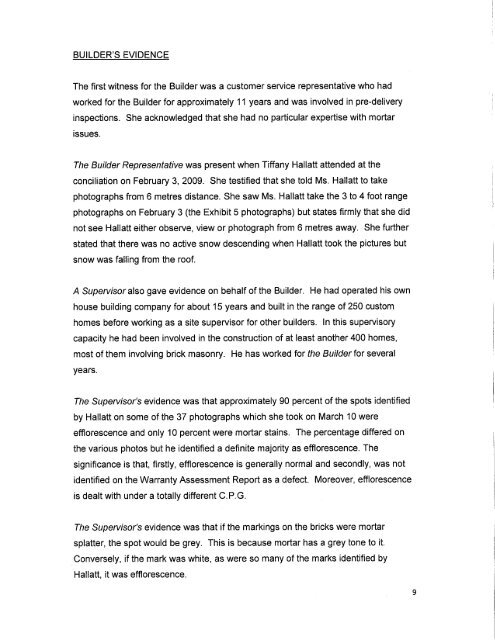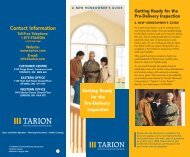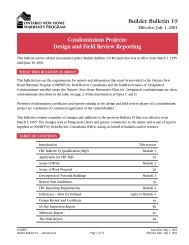BUILDER ("Applicant" and TARION WARRANTY CORPORATION ("Respondent ...
BUILDER ("Applicant" and TARION WARRANTY CORPORATION ("Respondent ...
BUILDER ("Applicant" and TARION WARRANTY CORPORATION ("Respondent ...
You also want an ePaper? Increase the reach of your titles
YUMPU automatically turns print PDFs into web optimized ePapers that Google loves.
<strong>BUILDER</strong>'S EVIDENCE<br />
The first witness for the Builder was a customer service representative who had<br />
worked for the Builder for approximately 11 years <strong>and</strong> was involved in pre-delivery<br />
inspections. She acknowledged that she had no particular expertise with mortar<br />
issues.<br />
The Builder Representative was present when Tiffany Hallatt attended at the<br />
conciliation on February 3, 2009. She testified that she told Ms. Hallatt to take<br />
photographs from 6 metres distance. She saw Ms. Hallatt take the 3 to 4 foot range<br />
photographs on February 3 (the Exhibit 5 photographs) but states firmly that she did<br />
not see Hallatt either observe, view or photograph from 6 metres away. She further<br />
stated that there was no active snow descending when Hallatt took the pictures but<br />
snow was falling from the roof.<br />
A Supervisor also gave evidence on behalf of the Builder. He had operated his own<br />
house building company for about 15 years <strong>and</strong> built in the range of 250 custom<br />
homes before working as a site supervisor for other builders. In this supervisory<br />
capacity he had been involved in the construction of at least another 400 homes,<br />
most of them involving brick masonry. He has worked for the Builder for several<br />
years.<br />
The Supervisor's evidence was that approximately 90 percent of the spots identified<br />
by Hallatt on some of the 37 photographs which she took on March 10 were<br />
efflorescence <strong>and</strong> only 10 percent were mortar stains. The percentage differed on<br />
the various photos but he identified a definite majority as efflorescence. The<br />
significance is that, firstly, efflorescence is generally normal <strong>and</strong> secondly, was not<br />
identified on the Warranty Assessment Report as a defect. Moreover, efflorescence<br />
is dealt with under a totally different C.P.G.<br />
The Supervisor's evidence was that if the markings on the bricks were mortar<br />
splatter, the spot would be grey. This is because mortar has a grey tone to it.<br />
Conversely, if the mark was white, as were so many of the marks identified by<br />
Hallatt, it was efflorescence.<br />
9










